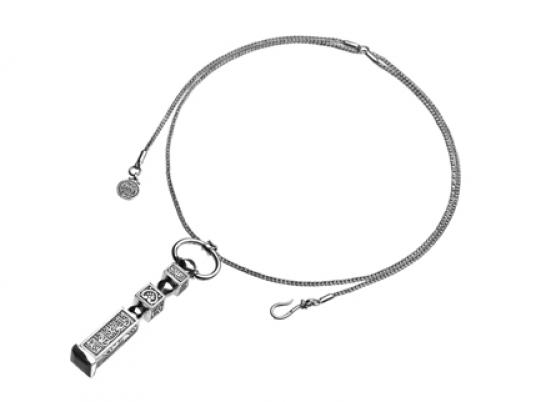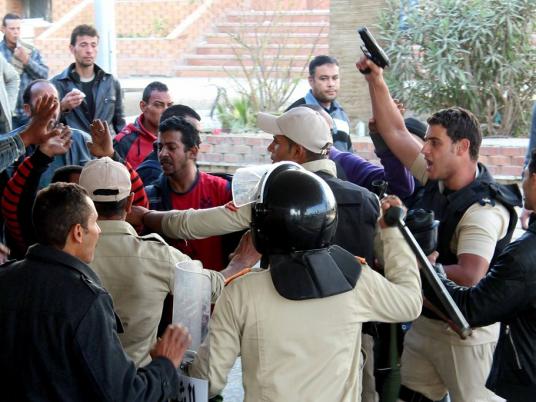
I barely knew Ahmed Basiony in person. I only got to meet him casually at exhibition openings around downtown or ran into him on the side street leading up to the Townhouse Gallery.
I did hear much about his artistic experiments, though, how groundbreaking they were in the local scene, and how they inspired so many artists. And luckily, I got to see his art projects on two occasions.
The first was at the second "Form Through Light" exhibit in 2005; the second at the 2010 Cairo Documenta show. In the latter, he presented an exciting work that visitors, regardless of their background, could naturally engage with.
“ASCII Doesn’t Speak Arabic” was interactive, entertaining and, at the same time, conceptually engaging. Few works could be described in those terms.
As visitors entered one of the back rooms at downtown’s Viennoise Hotel, their image gradually formed on the wall using letters from the Arabic alphabet. The projection changed as people moved and, eventually, a group of visitors could form words or even sentences from the letters making up the headshots.
Yes, we could control our image and its formations through our body movement. But that was not the only goal Basiony wanted to achieve. Through his experimentation with Open Source programing, he managed to highlight the Arabic alphabet in the ASCII (American Standard Codes for Information Interchange) programming code.
Basiony was killed on 28 January 2011 while protesting and filming the street clashes around Tahrir Square. Mainstream media — generally not interested in contemporary arts — gave him much attention and he was dubbed the “martyred artist.”
Still, very few seemed to be able to speak of his diverse body of work. Very few had seen it.
A few months later, the Culture Ministry announced that Basiony would represent Egypt at the 54th Venice Biennale. His friend and mentor Shady El Noshokaty was assigned the responsibility of organizing the show and from there things began to escalate: arguments about the ministry abusing his legacy and whether the Venice exhibit — video documentation of his 2010 performance, “Thirty Days Running in Place,” along with footage of street protests he filmed from 25–27 January 2011 — actually reflected Basiony’s work.
Like many Egyptians who found it hard to travel to the Venice Biennale, I did not get to see the show, but waited patiently for the promised exhibition in Cairo.
Almost a year and a half later, the Venice exhibit was shown in Cairo as part of a mega retrospective of Basiony’s work at Darb 1718, the American University in Cairo’s Sharjah Gallery, and Noshokaty’s new art educational foundation ASCII in Ard al-Lewa. To everyone’s delight, the retrospective was also organized and curated by Noshokaty. Finally, we thought, we would get to see Basiony’s work.
Noshokaty curated the exhibition so that Basiony’s more recent sound, video and interactive works were on display at Darb 1718, whereas the Venice project and documentation of the many workshops he gave at the Helwan Faculty of Art Education were shown at the American University in Cairo and ASCII, respectively.
In an interview with Egypt Independent, Noshokaty explained that he conceived the retrospective as an educational exhibit, one that other artists and students could learn from, an inspiration for different possibilities and paths they might want to explore. “That was a curatorial decision,” he said, one that he made from the beginning and part of his vision for the show.
As I visited the exhibition at Darb 1718, however, I did not feel I was seeing Basiony’s work but rather a take on it, one so strong that it became difficult and even confusing to navigate. Even those quite familiar with his work had a hard time following through.
I went back five times, watching the videos and projections, and reading the long explanatory texts and visual aids on the walls — each time trying to decipher where the work was from what was on display, to engage with it emotionally, personally.
Such engagement is what often leaves the strongest impact. Did it work? Not really.
Different materials were grouped for visitors to draw relationships between them. In one gallery on the top floor of Darb 1718, video documentation of Basiony’s 2009 “Symmetrical System” — a performance he did at the “Body Invisible” exhibition at the historic Mawlawiyah Palace — looped on a screen, while the famous street cleaner’s blue uniform, the rubber boots and bags of clothes pegs he wore for the performance, and later at Tahrir Square, hung from the ceiling.
For “Symmetrical System,” Basiony fixed a rubber material treated and painted to look like human flesh to the floor of the theater stage at the palace, and then gradually shaped and stitched it while in uniform, as a performer dressed in Baroque-style dress moved on its surface.
We do not really know why he wore the same costume to the square in 2011, though some interpreted it as possibly being another performance. The Darb 1718 exhibit seems to emphasize that since, in the same gallery, we see footage of running feet on the streets of Tahrir, playing on a screen fixed to the floor.
In a review of the 2011 Egyptian Pavilion in Venice for Egypt Independent, art historian Angela Harutyunyan wrote that Basiony’s art was framed by the state in relation to his role as a citizen-activist in such a way that “the viewer’s experience is pre-emptively foreclosed.” The same could be said for the exhibition of “Symmetrical System” at Darb 1718 and the presentation of the Venice project at the American University in Cairo.
Too strong were the overlays, and hanging the costumes he wore during the “Symmetrical System” and “Thirty Days Running in Place” performances next to the documentary footage simply emphasized the fact that he was dead and that his artistic equipment had become a sort of artifact shown at a museum, despite Noshokaty’s best intentions.
Noshokaty explained his decision to show the objects in that the exhibition was meant to be documentary. And that to screen the footage Basiony shot by saying it could be the reason for his death. He added that it showed the various aspects of Basiony’s personality — perhaps even his thought process. But for exhibition visitors, there was too much of Noshokaty’s own vision and interpretation, and not enough of Basiony’s.
For “ASCII Doesn’t Speak Arabic,” the visual aids at Darb 1718 somehow worked, explaining the code and how images are formed using keyboard art. But, because the laptop that operates the software and constructs the images was only there for the opening night of the exhibition, many visitors found themselves left with a concept, without being able to see how Basiony applied it and the play involved in it.
Perhaps the aspects that best reflected Basiony were the documentary footage and photographs Noshokaty collected and screened from the workshops and from artist friends, as well as the sound art pieces visitors could listen to through headphones. Only then could we see for ourselves how he taught and mediated complex concepts to his students, like he did through his art practice.
Leaving the three shows, one is left with a strong impression of how dedicated and creative an artist Basiony was, working across different media and constantly pushing their boundaries. We also regret never getting to know him and see his work firsthand.
Noshokaty says Basiony’s friends should dedicate more effort to his memory. Numerous exhibits could be made in the future from the many works he produced during his decade-long career. Maybe then — depending on how they are shown — we will get to experience them for ourselves.
This piece was originally published in Egypt Independent's weekly print edition.


